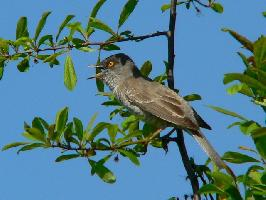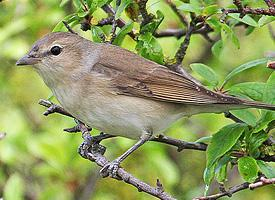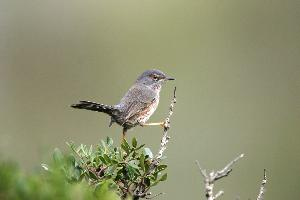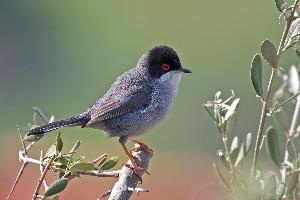
Popis zvířete
The Barred Warbler (Sylvia nisoria) is a fascinating bird species belonging to the Sylviidae family, which encompasses various warblers and related birds. This bird is particularly noted for its distinctive appearance and captivating behavior, making it a subject of interest among birdwatchers and ornithologists alike.Physical Description:
The Barred Warbler is a relatively large bird within its family, with a robust build that sets it apart from many other warbler species. Adult males typically exhibit a striking plumage characterized by a blend of grey and white tones. The upper parts of their bodies are predominantly grey, which beautifully contrasts with the underparts that are a lighter shade, often white with distinct dark grey bars or streaks. This barred pattern is especially prominent on the flanks and under the tail, giving the bird its common name. Females and juveniles are similar in appearance but tend to have a more subdued coloration, with the bars less pronounced and the overall plumage leaning towards brownish tones.
Size and Dimensions:
On average, Barred Warblers measure about 15 to 17 centimeters in length, with a wingspan that ranges from 22 to 26 centimeters. They weigh approximately 22 to 38 grams, with slight variations depending on age and sex.
Habitat and Distribution:
The Barred Warbler is predominantly a migratory species, with its breeding grounds located across a broad swath of Eastern Europe and Western Asia. This bird prefers habitats characterized by open woodland, scrublands, and thickets, often with a preference for areas with dense bushes or small trees. During the winter months, it migrates to the warmer climates of Eastern Africa, where it can be found in similar scrub and thicket environments.
Behavior and Diet:
This species is known for its skulking behavior, often remaining hidden within dense foliage. Despite this elusive nature, the Barred Warbler can sometimes be spotted perched openly when singing. Its diet is varied, consisting predominantly of insects and other small invertebrates during the breeding season. Berries and small fruits become more important food sources during migration and in the winter quarters.
Reproduction:
The breeding season of the Barred Warbler typically commences in late spring, with the construction of a well-hidden nest in dense bushes or low in trees. The female lays a clutch of 4 to 6 eggs, which she incubates for about 12 to 14 days. Both parents are involved in feeding the chicks, which fledge approximately 10 to 12 days after hatching. The family unit may remain together for some time before the juveniles become fully independent.
Conservation Status:
Currently, the Barred Warbler is classified as Least Concern by the International Union for Conservation of Nature (IUCN). While the species is widespread and not immediately threatened on a global scale, local populations may be affected by habitat loss and degradation. Conservation efforts are focused on preserving natural habitats and monitoring population trends to ensure the long-term survival of this remarkable bird species.
In summary, the Barred Warbler is a captivating bird with a distinctive appearance and intriguing behaviors. Its presence enriches the biodiversity of its natural habitats, making it a cherished species among bird enthusiasts and an important component of its ecosystem.
Podobná zvířata
Nové fotografie zvířat
Top 10 zvířat
- Chinese water dragon (Physignathus cocincinus)
- Galápagos tortoise (Geochelone nigra complex)
- Dolphin gull (Leucophaeus scoresbii)
- Japanese macaque (Macaca fuscata)
- Colombian red howler (Alouatta seniculus)
- Sea urchins (Echinoidea)
- Moustached guenon (Cercopithecus cephus)
- Diana monkey (Cercopithecus diana)
- Colossal squid (Mesonychoteuthis hamiltoni)
- Common house mosquito (Culex pipiens)


